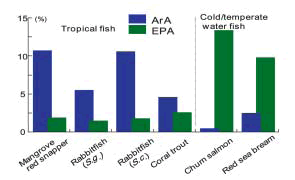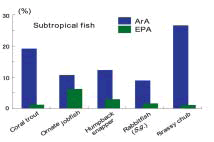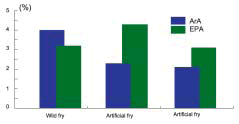The importance of arachidonic acid in fry production of tropical/subtropical fish species
Description
[Objectives]
The mass production of marine fish fry used in aquaculture and aqua-ranching has progressed remarkably due to the discovery of the nutritional importance of eicosapentaenoic acid (EPA) and docosahexaenoic acid (DHA) to marine fish, and the establishment of cultivation technologies of EPA/DHA-enriched feeds. As of now, most studies on essential fatty acids in relation to fry production have been focused on EPA and DHA. However, emphasis has not been previously placed on the importance of arachidonic acid (ArA), since ArA is found in only small quantities in cold/temperate water fish. In a preliminary study, we discovered that the eggs and larvae of the mangrove red snapper (Lutjanus argentimaculatus) contain relatively high ArA contents compared to fish living in cold/temperate waters. Moreover, information on the fatty acid composition of eggs and gonads of tropical and subtropical fish has been relatively limited until the present. We thus investigated ovarian fatty acid composition of aquacultural fish in the central Philippines and southern Japan, paying special attention to ArA and EPA content.
[Results]
Ovarian polar lipids were found to have intermediate or high ArA levels, but relatively low EPA levels; consequently, high ArA/EPA ratios (> 4.0) were observed in wild mangrove red snapper, two species of rabbitfish (Siganus guttatus and S. canaliculatus) and coral trout (Plectropomus leopardus), all of which were sampled in the central Philippines (Fig. 1). Similar trends were observed in wild coral trout, rabbitfish (S. guttatus), humpback snapper (L. gibbus), ornate jobfish (Pristipomoides argyrogrammicus) and brassy chub (Kyphosus vaigiensis) in southern Japan (Fig. 2). Not only ovaries, but also tendons and liver contained relatively higher ArA levels than EPA levels in all species in the present study, regardless of the sample source (data not shown). Fig. 3 shows ArA and EPA levels of polar lipids in wild-caught and hatchery-produced mangrove red snapper fry (whole). The hatchery-produced fry displayed lower ArA levels and higher EPA levels than did wild-caught fry. Overall, aquacultural species in central Philippines and southern Japan show high ArA and low EPA content, thus having high ArA/EPA ratios relative to cold/temperate water fish. The present results indicate that ArA is not a minor component of the eggs and larvae of tropical and subtropical fish, suggesting that ArA may have greater nutritional significance in relation to egg development and larval growth in tropical/subtropical fish than in cold-water fish. This information can be utilized in formulating guidelines for the future development of appropriate broodstock cultivation technology and larval diet development in tropical and subtropical areas. As of yet, the present findings on the potential value of ArA have not been applied to fry production technology in tropical/subtropical areas, but broodstock management and larviculture technologies based on the nutritional traits of tropical fish should be developed as rapidly as possible in order to stabilize fry supply and availability. Along these lines, we have initiated a follow-up project on the effects of dietary ArA on egg/larval quality in mangrove red snapper.
Figure, table
-
Fig. 1. ArA and EPA levels (%) of ovarian polar lipids in tropical fish in the Philippines (mangrove red snapper, rabbit fish and coral trout), cold-water fish (chum salmon) and temperate water fish (red sea bream). -
Fig. 2. ArA and EPA levels (%) of ovarian polar lipids in subtropical fish (southern Japan). -
Fig. 3. ArA and EPA levels (%) of wild-caught and hatchery-produced mangrove red snapper fry.
- Affiliation
-
Japan International Research Center for Agricultural Sciences Fisheries Division
- Classification
-
Technical A
- Term of research
-
FY2003 (FY2003-2005)
- Responsible researcher
-
OGATA Hiroshi ( Fisheries Division )
EMATA Arnil C. ( Southeast Asian Fisheries Development Center )
GARIBAY Esteban S. ( Southeast Asian Fisheries Development Center )
FURUITA Hirofumi ( Fisheries Research Agency )
Chong Ving-Ching ( University of Malaya )
- ほか
- Publication, etc.
-
Emata, A.C., Ogata, H.Y., Garibay, E.S. and Furuita, H. (2003): Advanced broodstock diets for the mangrove red snapper and a potential importance of arachidonic acid in eggs and fry. Fish Physiol. Biochem., 28, 489-491.
Ogata, H.Y., Emata, A.C., Garibay, E.S. and Furuita, H. (2004): Fatty acid composition of five candidate aquaculture species in Central Philippines. Aquaculture, 236, 361-375.
- Japanese PDF
-
2003_26_A3_ja.pdf2.11 MB
- English PDF
-
2003_26_A4_en.pdf60.98 KB



